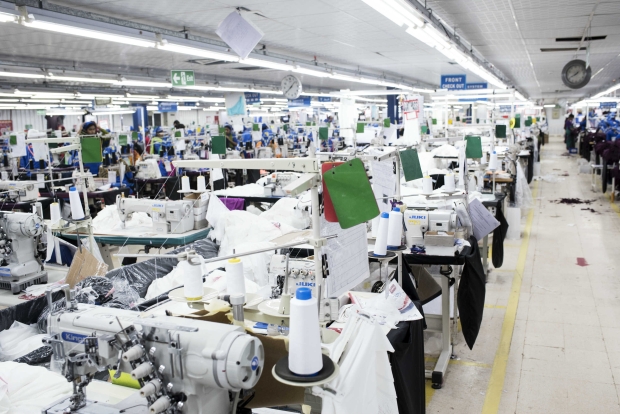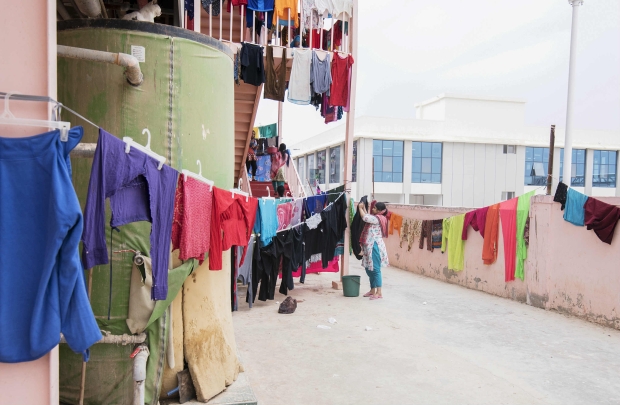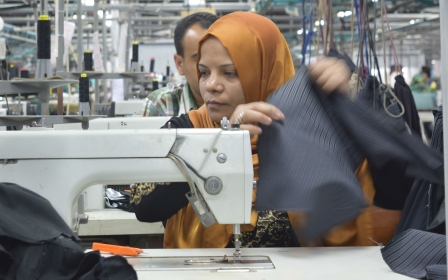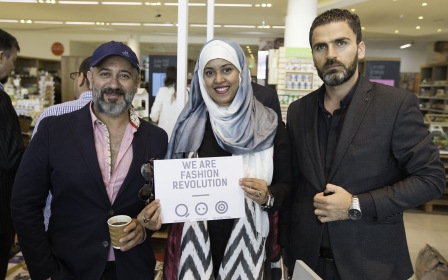As Jordan's garment sector grows, activists push for better migrant workers' rights
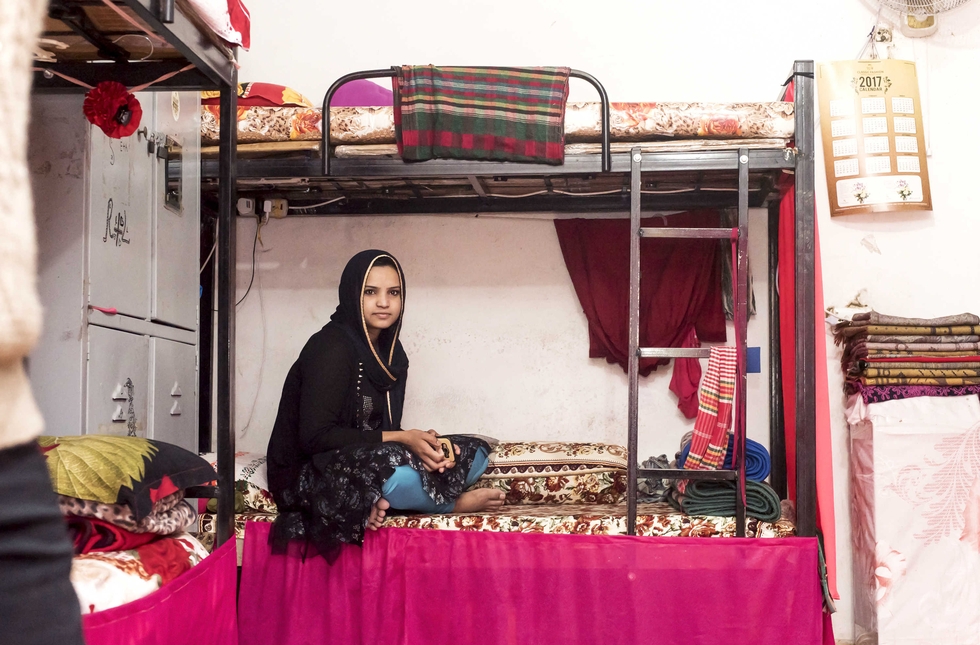
IRBID, Jordan - Layers of drying laundry swing on clotheslines strung atop dormitories inside Jordan's Al Hassan Industrial Estate. Down below, young women curled up on benches smile into their phone screens, talking to friends and family thousands of miles away.
It's Friday morning, the weekly day off for most migrant garment workers inside the complex, and the living quarters of Classic Fashion Apparel Industry Ltd Co are buzzing with activity. Music spills from open bedrooms as residents upend mattresses and sweep under bunk beds.
Sonia Aktar, a shy 20-year-old from Bangladesh, sits cross-legged on her tidy bed. She's in the middle of a three-year contract with Classic, the largest garment manufacturer in Jordan. It's her first time being outside her country and away from her family home.
"I have four sisters back in Bangladesh. I came here to send funds back to them," she said. "My family is poor, so I had to find a way to make more money."
Aktar is one of almost 50,000 migrant garment employees in Jordan, according to figures from the International Labour Organisation (ILO), coming from across South and Southeast Asia to produce items for US brands such as Nike, Under Armour and Target, in factories scattered across the kingdom.
I have four sisters back in Bangladesh, I came here to send funds back to them
- Sonia Aktar, migrant worker from Bangladesh
Stretching across more than a square kilometre of arid desert in northern Jordan, Al Hassan is the largest of 18 special industrial zones churning out readymade garments and textiles for export. It is also home to the thousands of migrant workers behind the production.
In October 2016, Jordan's labour and health ministries signed what was considered a milestone agreement allowing government officials to inspect housing facilities like these for the first time. But over a year on, the programme's effectiveness is still up for debate.
It may not be the first country to come to mind in the global garment trade, but Jordan's sector has become an economic bedrock.
Textile and clothing exports were valued at $1.3bn in 2016, according to World Bank figures.
Shaping regulation
Husam Saleh, chairman of the Jordan Garment, Accessories & Textile Exporters' Association, estimates revenues grew by 10 percent in 2017. As demand expands, he said, regulations must follow.
"We fully support the agreement between the health and labour ministries, because we need to have decent living conditions in the dorms," he said.
"Doing so also helps boost the reputation of the factories and the industry as a whole."
Qualified Industrial Zones (QIZs) including Al Hassan arrived to the kingdom in 1996 through a US Congress move to stimulate economic relations between Jordan, Israel and Egypt.
But Jordan's industry gained a unique advantage in 2000 with the forging of a new US free-trade agreement, which, after going into full effect in 2010, dropped the raw materials condition and opened tariff-free export of products made anywhere in country.
Fathallah Omrani, president of the General Trade Union of Workers in Textile, Garment and Clothing Industries, said US architects of both trade deals saw them as pathways to buoy slumping employment among Jordanians. But interest among local workers lagged even as foreign investment in the sector flourished. Omrani said factories moved to fill the void by bringing workers in from abroad.
Lack of local hires
Despite government-mandated local hire ratios and employment initiatives over the last 20 years, little about the sector's demographic has changed.
Female migrant workers from Bangladesh, Sri Lanka and Nepal still account for more than 75 percent of the garment workforce, according to ILO figures.
Saleh attributes part of the ongoing struggle to hire locally to conservative social values in the kingdom and an unwillingness among Jordanians to work in manufacturing.
"Sometimes it's the father, husband or brother who doesn't want their female family members to work [in the factories]," he said. "And you simply cannot force people to work."
Another factor is the salary. Garment workers are paid at least the national monthly minimum wage in Jordan, set to raise from JD 205 ($290) to JD 220 ($310) this year. Foreign workers are currently paid almost JD 120 ($169), with the remaining amount going to accommodation costs standardised through collective bargaining agreements.
While it's an increase from garment salaries migrants find in their home countries, Saleh said locals need higher wages to meet living costs in Jordan’s urban areas.
“'Like any capital, Amman is more expensive, so a salary of JD 250 or even 300 is not sustainable for a family without an additional income," he said. "Jordanians are part of our industry in rural areas where that wage goes farther."
As Omrani said, regulating the conditions inside QIZs has not always been clearcut. Violations inside the zones placed Jordan on the US State Department's List of Goods Produced by Child Labor or Forced Labor in 2009, a designation removed in 2016.
"Factory owners were making workers pay for food and water and making them share rooms with 16 other people; they were acting like the mafia," he said.
"In 2011 we had 42 separate strikes [across the country] about food, dorms, issues with managers; everything."
Allegations of human trafficking
Linda al-Kalash, who heads Jordanian migrant rights group Tamkeen for Fields of Aid, said her centre continues to document similar violations.
"[Garment workers] usually bring collective cases where we hear from fifty workers or a hundred workers," Khalash said.
"I think every year we get around 10 cases, which is still a huge number because we are talking about many workers per case."
In 2016, Tamkeen spearheaded a human trafficking case against two factories in Al Hassan for reports spanning abuse on the production floor, failure to pay salaries, seizure of passports and overcrowded living quarters.
The labour ministry ordered it shut down early last year after repeated violations went unaddressed by factory management.
Programmes like Better Work, a partnership between the ILO and the International Finance Corporation, have helped to establish legal frameworks for migrant garment workers since coming to Jordan in 2009. The programme does its own compliance assessments across the sector and records rights violations on a public transparency portal online.
Prior to the ministerial agreement in 2016, dorm inspections were only being carried out by Better Work teams. Programme Director Tareq Abu Qaoud said conditions vary greatly among companies.
"I saw some photos from Top Tex and definitely, it was extremely bad," he said. "But on the other hand, there are some dorms in the sector with higher standards."
Gradual reforms
As Abu Qaoud notes, sector-wide requirements for QIZ dorms did not come to Jordan until 2010. That year, the labour ministry rolled out regulations on overtime pay, recruitment fees and factory working conditions. Inside dorms, health officials introduced measures spanning fire safety, room capacities and food standards. But a lack of staff within the health ministry stalled monitoring.
"Establishing standards was the first step, but who was inspecting [to ensure factory compliance]?" he said.
"The health ministry's main focus is on high-risk enterprises like hospitals and schools. Put simply, the dorms were not a top priority given the limited resources of the health ministry."
The 2016 agreement looked to mitigate the gap by shifting dorm responsibilities to labour officials, who already carry out regular inspections inside QIZs.
After sessions to train labour inspectors on health protocol readied 75 officials for the job, Department of Labour head of inspection Abdallah Al Ajbour said his staff has started including dorms in routine factory visits and responding to housing claims lodged through the labour ministry hotline.
"We used to get a lot of complaints and would have to pass them along to the ministry of health, but they were not always able to make it to these inspections," he said. "In the year since we took over, the number of complaints we receive about dorms has dropped dramatically."
Abu Qaoud believes the move is an important first step.
"I think the starting point comes from well-equipped labour inspectors, a strong social dialogue, and definitely a genuine intention from the employers to create a good working condition," he said.
Still, the agreement is only the latest in a labour rights process nearly two decades in the making. Tamkeen director Kalash said legal changes like these are encouraging, but practical steps can be elusive.
"It's good to have this agreement between the ministries of labour and health, but also I hope to see it actually implemented, because we've had many problems regarding that in the past," she said. "Here in Jordan, we have a good legal baseline to work off, but the problem is often how to implement these agreements."
New MEE newsletter: Jerusalem Dispatch
Sign up to get the latest insights and analysis on Israel-Palestine, alongside Turkey Unpacked and other MEE newsletters
Middle East Eye delivers independent and unrivalled coverage and analysis of the Middle East, North Africa and beyond. To learn more about republishing this content and the associated fees, please fill out this form. More about MEE can be found here.


